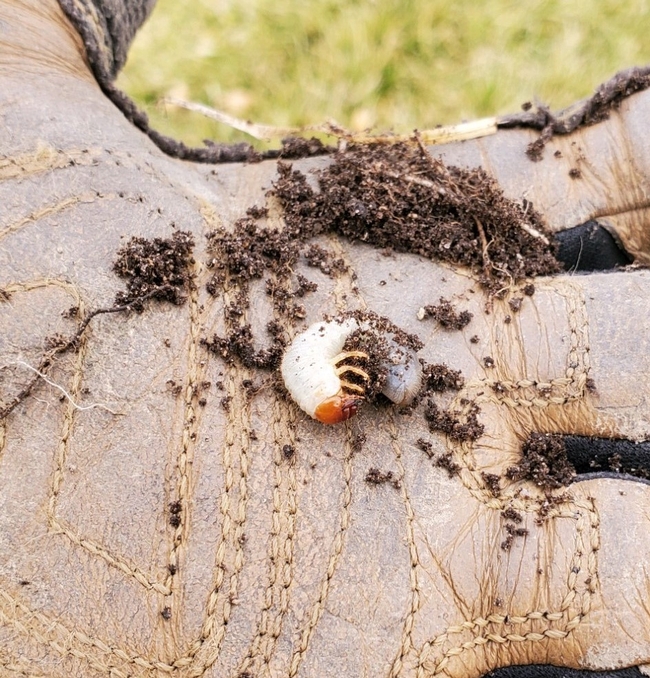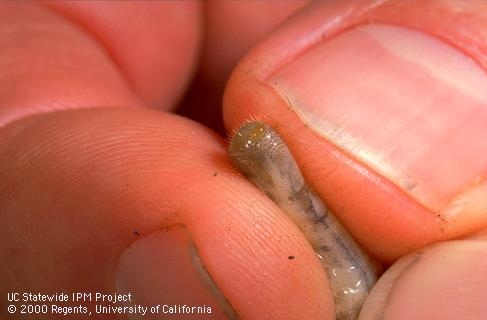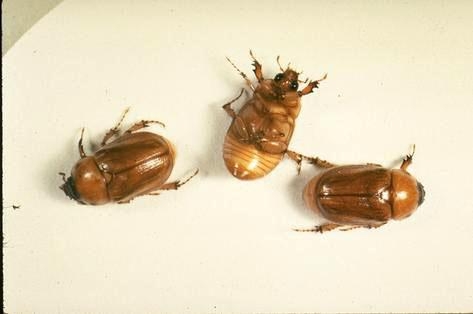I was dealing with a gopher problem in a lawn awhile back and I came across another turfgrass pest that you may or may not be familiar with; a chafer beetle.
These white grubs are the immature larval form of a chafer beetle.
Here in California we deal mainly with the masked chafer (Cyclocephala spp.). Mature grubs have white or cream colored, C-shaped bodies, six legs on their upper half, and a chestnut brown head. They can be confused with the somewhat smaller black turfgrass ataenius larvae (Ataenius spretulus). To identify the difference between the two, look at the tip of the abdomen (the opposite end from the head) for the arrangement of bristles and overall anatomy, we call this the raster pattern. A chafer's raster will have a transverse anal slit with an indistinct pattern of bristles all over. An ataenius will have two distinct pad-like structures on the tip of the anal slit.
The chafer grubs feed on turf roots in early spring then stop around May to pupate with adults emerging around June to mate. Adults actually have non-functional mouthparts and so do not cause feeding damage, in fact they die of starvation shortly after laying eggs. Adults are about 3/4 inches long with golden brown bodies and they emerge during the night with a strong attraction to light. If you see adults during the summer, eggs are likely being laid in your grass. Eggs hatch around August and the grubs do most of their damage in September and October before moving deeper into the soil to overwinter until the spring.
Damage looks like drought symptoms in turf: brown, blueish, or gray spots, brittle straw colored grass, thinning stands, and footprinting. These symptoms are from the extensive root feeding of the grubs as the grass loses much of its ability to take up water. You may also see vertebrate feeding from birds or skunks that can cause further damage digging for the grubs. Spots of affected turf may be small, only being a foot or two across but may combine with other spots to form large sections of damaged turf. A hallmark of grub damage is that damaged turf can be peeled back from the soil like a carpet, due to the turf having no roots.
Insect damage in home lawns is rarer than you might think, with abiotic problems like poor irrigation, mowing, or fertility practices being a more likely culprit for a struggling lawn. If there is an insect pest make sure you correctly identify the insect before intervening with any control measures. Also remember that the presence of a pest doesn't always necessitate control. A healthy lawn can withstand damage from a few grubs and a robust lawn is always the best defense against pest damage.
Damaged turf can be helped by irrigating more frequently to keep soil moist around the lawns now shallow roots. Lawn aeration can also kill segments of grub populations. Reserve any kind of chemical intervention until you see 6 or more grubs per square foot. Several insecticides are available on the market for chafers or white grub control just look at the label. UC IPM has a page dedicated to masked chafers, but keep in mind the pesticides recommended there are for professionals.
Always read and understand the label of any pesticide you intend to use. Be careful to refrain from applying insecticides (especially broad spectrum) if there are flowering plants in and around the lawn; this includes weeds like clover or dandelions as it can harm beneficial insects like pollinators that may come into contact with them.


